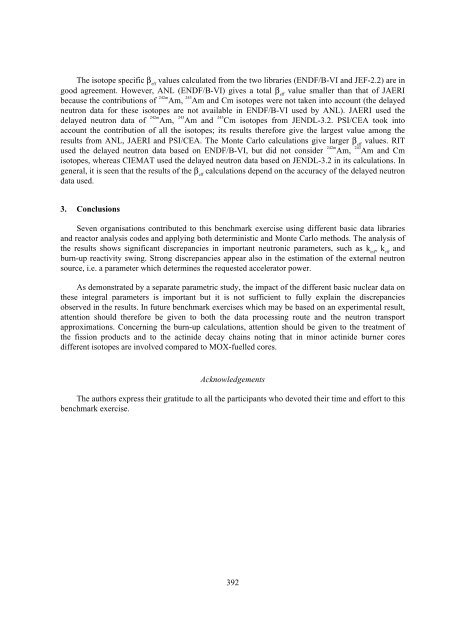OECD/NEA Benchmark Calculations for Accelerator Driven Systems
OECD/NEA Benchmark Calculations for Accelerator Driven Systems
OECD/NEA Benchmark Calculations for Accelerator Driven Systems
Create successful ePaper yourself
Turn your PDF publications into a flip-book with our unique Google optimized e-Paper software.
The isotope specific β eff<br />
values calculated from the two libraries (ENDF/B-VI and JEF-2.2) are in<br />
good agreement. However, ANL (ENDF/B-VI) gives a total β eff<br />
value smaller than that of JAERI<br />
because the contributions of 242m Am, 243 Am and Cm isotopes were not taken into account (the delayed<br />
neutron data <strong>for</strong> these isotopes are not available in ENDF/B-VI used by ANL). JAERI used the<br />
delayed neutron data of 242m Am, 243 Am and 245 Cm isotopes from JENDL-3.2. PSI/CEA took into<br />
account the contribution of all the isotopes; its results there<strong>for</strong>e give the largest value among the<br />
results from ANL, JAERI and PSI/CEA. The Monte Carlo calculations give larger β eff<br />
values. RIT<br />
used the delayed neutron data based on ENDF/B-VI, but did not consider 242m Am, 243 Am and Cm<br />
isotopes, whereas CIEMAT used the delayed neutron data based on JENDL-3.2 in its calculations. In<br />
general, it is seen that the results of the β eff<br />
calculations depend on the accuracy of the delayed neutron<br />
data used.<br />
3. Conclusions<br />
Seven organisations contributed to this benchmark exercise using different basic data libraries<br />
and reactor analysis codes and applying both deterministic and Monte Carlo methods. The analysis of<br />
the results shows significant discrepancies in important neutronic parameters, such as k inf<br />
, k eff<br />
and<br />
burn-up reactivity swing. Strong discrepancies appear also in the estimation of the external neutron<br />
source, i.e. a parameter which determines the requested accelerator power.<br />
As demonstrated by a separate parametric study, the impact of the different basic nuclear data on<br />
these integral parameters is important but it is not sufficient to fully explain the discrepancies<br />
observed in the results. In future benchmark exercises which may be based on an experimental result,<br />
attention should there<strong>for</strong>e be given to both the data processing route and the neutron transport<br />
approximations. Concerning the burn-up calculations, attention should be given to the treatment of<br />
the fission products and to the actinide decay chains noting that in minor actinide burner cores<br />
different isotopes are involved compared to MOX-fuelled cores.<br />
Acknowledgements<br />
The authors express their gratitude to all the participants who devoted their time and ef<strong>for</strong>t to this<br />
benchmark exercise.<br />
392

















